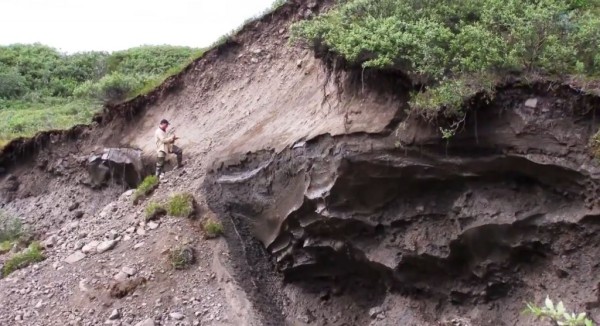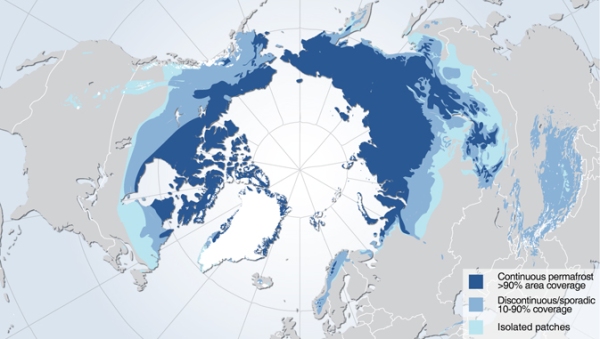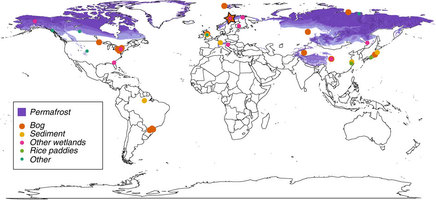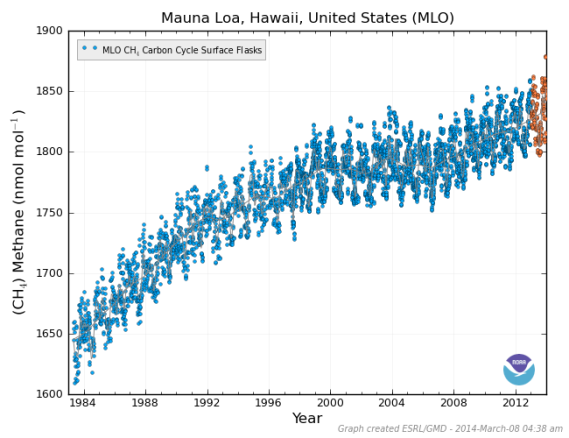by Robert Schribbler, robertscribbler.com, March 14, 2014
An emerging methane feedback in the Arctic. It’s something that, since last summer, I’ve been calling the Arctic Methane Monster. A beast of a thing composed of giant reserves of sea bed methane and an immense store of carbon locked away in Arctic tundra.
How dangerous and vicious the monster ends up being to a world set to rapidly warm by humans depends largely on three factors. First — how fast methane is released from warming stores in the sea bed. Second — how swiftly and to what degree the tundra carbon store is released as methane. Third — how large the stores of carbon and methane ultimately are.
Thawing permafrost and organic carbon in Yedoma region of Russia. Image source: NASA.
On the issue of the first and third questions, scientists are divided between those like Peter Wadhams, Natalia Shakhova and Igor Simeletov who believe that large methane pulses from a rapidly warming Arctic Ocean are now possible and warrant serious consideration and those like Gavin Schmidt and David Archer — both top scientists in their own right — who believe the model assessments showing a much slower release are at least some cause for comfort. Further complicating the issue is that estimates of sea-bed methane stores range widely with the East Siberian Arctic Shelf region alone asserted to contain anywhere between 250 and 1500 gigatons of methane (see Arctic Carbon Stores Assessment Here).
With such wide-ranging estimations and observations, it’s no wonder that a major scientific controversy has erupted over the issue of sea bed methane release. This back and forth comes in the foreground of observed large (but not catastrophic) sea-bed emissions and what appears to be a growing Arctic methane release. A controversy that, in itself, does little inspire confidence in a positive outcome.
But on the second point, an issue that some are now calling the compost bomb, most scientists are in agreement that the massive carbon store locked in the swiftly thawing tundra is a matter of serious and immediate concern.
Tundra Thaw by Human GHG Now Practically Inevitable
At issue here is the initial power of the human heat forcing and what consequences that forcing is likely to unlock. Consequences that are directly tied to the amount of greenhouse gasses we emit. A total forcing that is now likely equivalent to around 425 CO2e when taking into account the effect of human aerosols and an even more ominous 480 CO2e when and if those aerosols fall out (IPCC and MIT).
The first number, 425 CO2e, were it to remain stable over years, decades and centuries, is enough push global temperatures above the 1.5 C warming threshold that would thaw the northern hemisphere tundra. And within this tundra is locked a store of about 1,500 gigatons of carbon. A massive store that is set to eventually, thaw, decompose and release its carbon as either CO2 or methane over the long period of warmth that is to come.
Northern Hemisphere Permafrost Zones. Image source: NASA.
The immense size of this carbon store represents an extreme risk both for extending the period of human warming and for, potentially, generating a feedback in which natural warming adds to, rather than simply extends, human warming. By comparison, human fossil fuel emissions have already resulted in about 540 gigatons of carbon being released into the atmosphere. The tundra store alone represents nearly three times this amount. But the concern is not just the massive size of the tundra store now set to thaw, or the rate at which the tundra will, eventually, release its carbon to the atmosphere. The concern is also how much of the tundra store carbon is released as either methane or CO2.
Methane Provides a Strong Amplifying Feedback
Since methane’s radiative absorption is about 35 times that of CO2 by volume in the IPCC climate assessments (and its short term global warming potential is as much as 72 to 105 times that of a comparable amount of CO2) and since methane release sets off other feedbacks by turning into CO2 after it is oxidized and by increasing atmospheric water vapor, a strong greenhouse agent in its own right, a significant portion of tundra carbon being liberated as methane could result in a rather powerful heat amplification. In the worst case, such an amplification could set off conditions similar to those during which other mini-greenhouse gas runaways occurred — such as the Permian, Triassic and PETM events.
Which is why the release of a new paper should be cause for serious concern.
Ancient Archaea – The Arctic Methane Monster’s Nasty Little Helpers
This week, a paper published in Nature Communications described findings based on a study of thawing Swedish permafrost. The study investigated how microbes responded to thawing tundra in various mires throughout warming sections of Sweden. What they discovered was the increased prevalence of an ancient methane producing micro-organism.
Billions of years ago, methane producing cyanobacteria or archaea were prevalent in the world’s oceans. The methane they produced helped keep the Earth warm at a time when solar output was much less than it is today. Later, as oxygen producing plants emerged, the archaea, to which oxygen was a poison, retreated into the anoxic corners of the more modern world. Today, they live in the dark, in the mud, or in the depths of oceans. There, they continue to eek out an existence by turning hydrogen and carbon dioxide into methane.
A kind of archaea, the newly discovered organism, named Methanoflorens stordalenmirensis, was found to be exploding through sections of rapidly melting Swedish tundra. In fact, it is so at home in regions of melting permafrost that it blooms in the same way algae blooms in the ocean. As a result, it comes to dominate the microbial environment, representing 90% of the methanogens and crowding out many of the other microbes.
Methanogen shows global distribution. Each dot indicates a location where Methanoflorens stordalenmirensis was discovered. Image source: Nature.
That these massive archaea blooms can effectively convert large portions of the newly liberated tundra carbon store into methane was not at all lost on researchers:
“Methanoflorens stordalenmirensis seems to be a indicator species for melting permafrost. It is rarely found where there is permafrost, but where the peat is warmer and the permafrost is melting we can see that it just grows and grows. It is possible that we can use it to measure the health of mires and their permafrost. The recently documented global distribution also shows, on a much larger scale, that this microbe spreads to new permafrost areas in time with them thawing out. This is not good news for a stable climate“, said study author Rhiannon Mondav.
So what we have here is a billions year old microbe that thrives in wet regions called mires where permafrost is melting, rapidly converts tundra carbon to methane, readily spreads to new zones where permafrost melt occurs, and explodes into algae like blooms to dominate these environments.
One could not ask for a set of more diabolic little helpers for the already very disturbing Arctic Methane Monster…
Implications Going Forward: Arctic Methane Emission Not Currently Catastrophic, But Likely to Continue to Grow
Recent research shows that the current methane emission from all natural sources north of 53 degrees north latitude is on the order of 81 trillion grams (TG) each year. A portion of this, about 17 TG, comes from the East Siberian Arctic Shelf. Other inputs are from sea bed sources, thawing tundra and existing wetlands in the region. Meanwhile, the global emission, including both human and natural sources is in the range of about 600 TG each year. Overall, this emission is enough to overwhelm current sinks by about 40 TG each year, which results in continuing increases of atmospheric methane.
Atmospheric methane levels since 1969, Mauna Loa, show levels rising by about 200 ppb over the 45 year period. Image source: NOAA ESRL.
As more and more of the tundra melts and as seabed methane continues to warm it is likely that total Arctic methane emissions will continue to rise, perhaps eventually rivaling or, in the worst case, exceeding the size of the human methane emission (350 TG). But, to do so, current Arctic and boreal emissions would have to more than quadruple — either through a slow increase (high likelihood) or through more catastrophic large pulse events (lower likelihood, but still enough for serious concern). By contrast, recent warm years have shown increases in the rate of methane flux/emission of around 5% with the average flux increase being around 2%.
It is worth noting that NOAA and a number of other agencies do track methane emissions in the Arctic but that a comprehensive tool set for accurately tracking the total emission does not appear to be currently available. Instead, various studies are conducted in an effort to capture total emissions levels. Monitoring does, however, track total atmospheric values.
[Readers, it is well worth going to the link to the post, below, and reading the comments.]
Links:
Link to blog post: http://robertscribbler.wordpress.com/2014/03/12/7749/











No comments:
Post a Comment